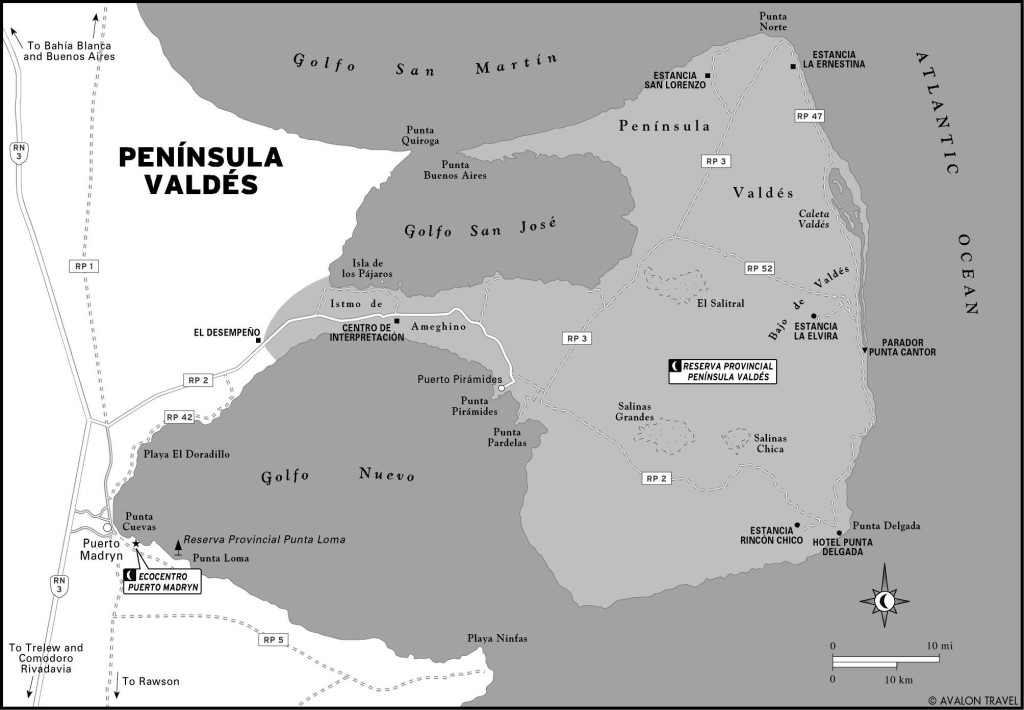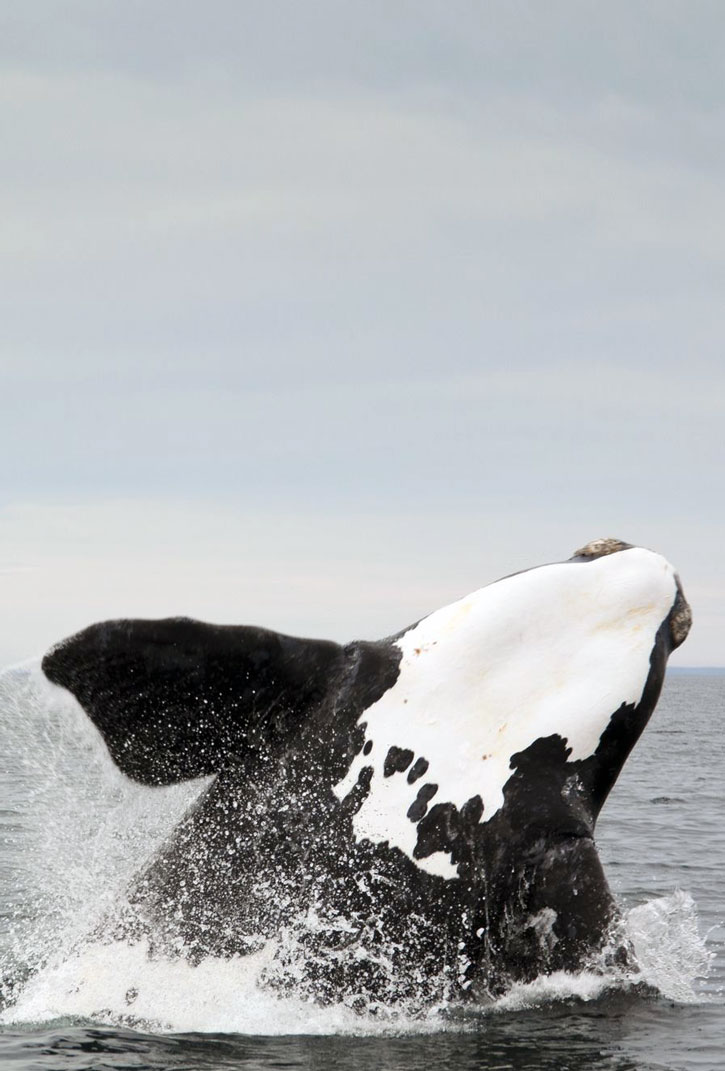Península Valdés itself, a provincial reserve rather than a national park, has more to offer than just whales. Some marine mammal species, ranging from sea lions to southern elephant seals and orcas, cover the beaches or gather in the Golfo San José, Golfo Nuevo, or the open South Atlantic all year. There are also concentrations of burrowing Magellanic penguins and flocks of other seabirds, plus herds of grazing guanacos and groups of sprinting rheas in the interior grasslands.
Connected to the mainland by the narrow Istmo de Ameghino, Península Valdés is 56 kilometers northeast of Puerto Madryn via RP 2, but visiting the major wildlife sites involves a circuit of roughly 400 kilometers to Puerto Pirámides and Punta Delgada via RP 2, Caleta Valdés and Punta Norte via RP 47, and RP 3 back to Puerto Pirámides. Beyond Puerto Pirámides, loose gravel and dirt can be hazardous to inexperienced drivers, especially with low-clearance vehicles.
Broad sandy beaches line much of the coast, but unconsolidated sediments make the steep headlands that rise above them dangerous to descend. Sheep estancias occupy most of the interior, whose Salina Grande depression (42 meters below sea level) is one of the world’s lowest points. The climate is dry, with high evaporation due to long hours of sunlight and perpetual winds.
At El Desempeño, at the west end of the Istmo de Ameghino, a provincial toll booth collects an admission fee (US$16 foreign adults, US$8 foreign children aged 6-12, US$4 Argentines, free for all children under 6).

Península Valdés
The main activity center is the hamlet of Puerto Pirámides (pop 565), which, like Puerto Madryn, enjoys a longer tourist season because of the whale- and orca-watching periods. Once the export point for salt from the Salina Grande depression, it has grown haphazardly, and water continues to be a problem in this desert environment. Since 2010, street names have changed: 25 de Septiembre (National Whale Day) replaces Primera Bajada, and 14 de Julio (the town’s anniversary) replaces Segunda Bajada. Other new street names include those of Antonio Soto and Facón Grande, leaders of the Santa Cruz anarchist rebellion of 1921, and of writer Osvaldo Bayer, whose book Los Vengadores de la Patagonia Trágica helped to reveal the facts.
Sometimes called Puerto Pirámide, the village has since reasserted its plurality. According to local accounts, when the Argentine navy used the area as a firing range, they destroyed two of the three pyramidal promontories that gave the settlement its original moniker.

A right whale breaches the surface of the water in Peninsula Valdés. Photo © Nicolas De Corte/123rf.
Many visitors book excursions in Madryn, but day trips are too brief for more than a glimpse of the best, especially if the operators spend too much time at lunch. Staying at Puerto Pirámides and contracting tours there is ideal for whale-watching, as you have the flexibility to pick the best time to go out.
Six Pirámides operators, some with offices in Madryn as well, offer whale-watching in semi-rigid rafts (which get closer to the animals) or larger catamarans: Tito Bottazzi (25 de Septiembre s/n, tel. 0280/4495050), Hydrosport (25 de Septiembre s/n, tel. 0280/4495065), Whales Argentina (25 de Septiembre s/n, tel. 0280/4495015), Punta Ballena (14 de Julio s/n, tel. 0280/4495112), Peke Sosa (14 de Julio s/n, tel. 0280/4495010), and Southern Spirit (25 de Septiembre s/n, tel.0280/4495094,). Prices start around US$62 but can cost more, depending on the vessel and the tour’s duration.
In Golfo San José, 800 meters north of the isthmus, penguins, gulls, cormorants, and herons all nest on Isla de los Pájaros, an offshore bird sanctuary. It’s off-limits to humans, but a stationary shoreline telescope magnifies the breeding birds. Near the telescope is a replica chapel of Fuerte San José, the area’s first Spanish settlement (from 1779, but destroyed by Tehuelches in 1810).
Puerto Pirámides has the most services, including the most affordable accommodations and food. June-December, whales are the main attraction, but beachgoers take over in January and February. Carless visitors can hike or bike to the sea lion colony at Punta Pirámide, four kilometers west, for vast panoramas and sunsets over the Golfo Nuevo.
Beneath the headlands at the peninsula’s southeastern tip, Punta Delgada is home to southern elephant seal and sea lion colonies, reached by trail from the lighthouse at the former naval station (now a hotel-restaurant). Hotel concessionaires provide English-speaking guides to lead tour groups and individuals, but they charge US$10 per person for those who do not eat at the restaurant. They have also turned the lighthouse into a museum and offer horseback tours.
On the peninsula’s eastern shore, about midway between Punta Delgada and Punta Norte, Caleta Valdés is a sheltered bay that’s fast becoming a lagoon as its ocean outlet fills with sediment. Meanwhile, Magellanic penguins swim north to a breeding colony and southern elephant seals haul up onto shore in the mating season. Even guanacos may be seen along the beach.
Where RP 47 and RP 3 meet at the peninsula’s northern tip, Punta Norte features a mixed colony of southern elephant seals and sea lions. In October-April, this is also the best place to see orcas, which lunge onto the beach to grab unwary pups. The museum here places marine mammals in both a natural and cultural context, thanks to exhibits on the indigenous Tehuelche and a historical account of the sealing industry.
Near Punta Norte, reached by a northwesterly road off RP 3, Estancia San Lorenzo conducts tours of its own Magellanic penguin colony but does not offer accommodations.
About 22 kilometers east of El Desempeño, at the west end of the Istmo de Ameghino, the Centro de Interpretación (7:30am-9pm daily) displays a complete right whale skeleton and also historical materials ranging from Tehuelche times to Spanish colonization and Argentine settlement for salt mining and sheep ranching. The informational panels are accompanied with good English translations. An observation tower offers panoramas across the northerly Golfo San José to the southerly Golfo Nuevo, and east across the peninsula’s interior.
The Dirección de Turismo (25 de Septiembre s/n, tel. 0280/4495048, 8am-9pm daily in summer, 8am-6pm the rest of the year) is the municipal tourist office.
In summer, from Puerto Madryn, Mar y Valle (tel. 0280/4450600) has five daily buses to Puerto Pirámides (US$5, 1.5 hours); the rest of the year this drops to as few as two. On a space-available basis, tour buses may allow passengers to disembark at Pirámides and return another day, but make advance arrangements.
Distances from Pirámides to other peninsula destinations are too great for non-motorized transport, so it’s worth considering a rental car in Puerto Madryn. Many consider day trips from Madryn too rushed.
Excerpted from the Fourth Edition of Moon Patagonia.